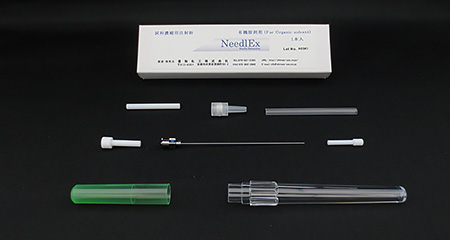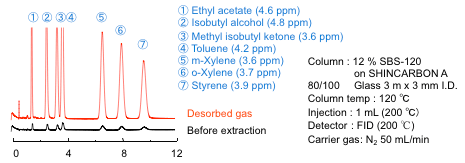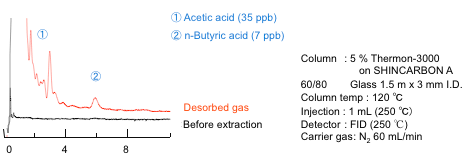NeedlEx
![]() NeedlEx: Specifications and Prices
NeedlEx: Specifications and Prices
Sample Extraction Needle
Features of NeedlEx
- The NeedlEx enables easy extractions of samples and provides superior reproducibility.
By attaching a NeedlEx needle to a gas sampler and simply aspirating a sample, the desired sample can be extracted selectively and accurately concentrated in a very short period of time. - Adsorbed samples can be stored in NeedlEx needles.
Extracted samples can be stored for approximately ten days by sealing both ends of NeedlEx needles using Teflon plugs included with each needle. - No additional equipment is required for the adsorption and desorption of samples. Desorption of samples is performed using the heat produced by gas chromatograph injection ports. Extracted samples can be injected into GCs using gas tight syringes and 1 mL of N2.
- NeedlEx needles can be used repeatedly.
By conditioning NeedlEx needles in GC injection ports for 3 minutes after each analysis, needles can be used approximately 25 to 30 times.

NeedlEx Types
- For organic solvents
Extractions of general organic solvents including ethyl acetate, isobutanol, methyl isobutyl ketone, toluene, xylene, and styrene, etc. - For amines
Extractions of short chain amines including trimethylamine, etc. - For fatty acids
Extractions of fatty acids (propionic acid, isobutyric acid, n-butyric acid, isovaleric acid). - For alcohols
Sampling of air containing monohydric alcohols with up to 3 carbon atoms, and solvents such as acetone and diethyl ether with boiling points below 100℃.
NeedlEx Specifications
Inner diameter: 0.5 mm
Outer diameter: 0.7 mm
Length: 85 mm Luer lock type needle with side hole

NeedlEx Measurement Ranges (Sample concentrations and sampling volumes)
1) Organic solvent type
Breakthrough volumes depend on the type of solvent being measured. When the concentration of an organic solvent in air is less than or equal to 100 ng/mL (and for samples with multiple constituents each with a concentration less than or equal to 100 ng/mL), please refer to the sampling volume table shown below.
| Sampling volume | Sample |
|---|---|
| 10 mL | Acetone, chloroform, cis-dichloroethylene, 1,2-dichloroethane, ethanol, methyl acetate, 2-propanol, tetrachloromethane, tetrahydrofuran, 1,1,1-trichloroethane, trichloroethylene |
| 50 mL | Ethyl acetate, isopropyl acetate, methyl ethyl ketone |
| 100 mL | n-Amyl acetate, 1-butanol, 2-butanol, n-butyl acetate, butyl cellosolve, chlorobenzene, cyclohexanol, cyclohexanone, dichlorobenzene, N,N-dimethylformamide, 1,4-dioxane, ethylbenzene, ethyl cellosolve, isoamyl acetate, isoamyl alcohol, isobutanol, isobutyl acetate, methyl cellosolve, n-propyl acetate, methyl n-butyl ketone, methylcyclohexanol, methylcyclohexanone, methyl isobutyl ketone, styrene, 1,1,2,2-tetrachloroethane, tetrachloroethylene, toluene, xylene |
* This product cannot be used for sampling of the low boiling point compounds methanol, dichloromethane, and diethyl ether. Please contact us for details regarding other gases.
2) Amine type
Trimethylamine in air can be sampled up to 300 ml when trimethylamine is present at concentrations of 0.7 ng/ml or less.
3) Fatty acid type
Propionic, isobutyric, n-butyric, and isovaleric acid can each be extracted up to an absolute value of 10 ug.
4) Alcohol type
Gas samples containing methanol can be sampled up to 50 ml. Samples that do not contain methanol can be sampled up to 200 ml.
Disposal of NeedlEx extraction needles
When disposing of NeedlEx extraction needles, separate and dispose of needle parts according to the type of material each part is made from. As NeedlEx needles are a potential source of injuries, place used needles in an appropriate metal container, and dispose of as waste metal.
Application Chromatograms
Organic solvent type
Standard organic solvents (20 mL sample)

Amine type
Trimethylamine in head space gas of dry chicken manure (100 mL sample)

Fatty acid type
Fatty acids in head space gas of shoes (300 mL sample)

Alcohol type
Analyses of headspace gas of wine (100 mL sampling)

